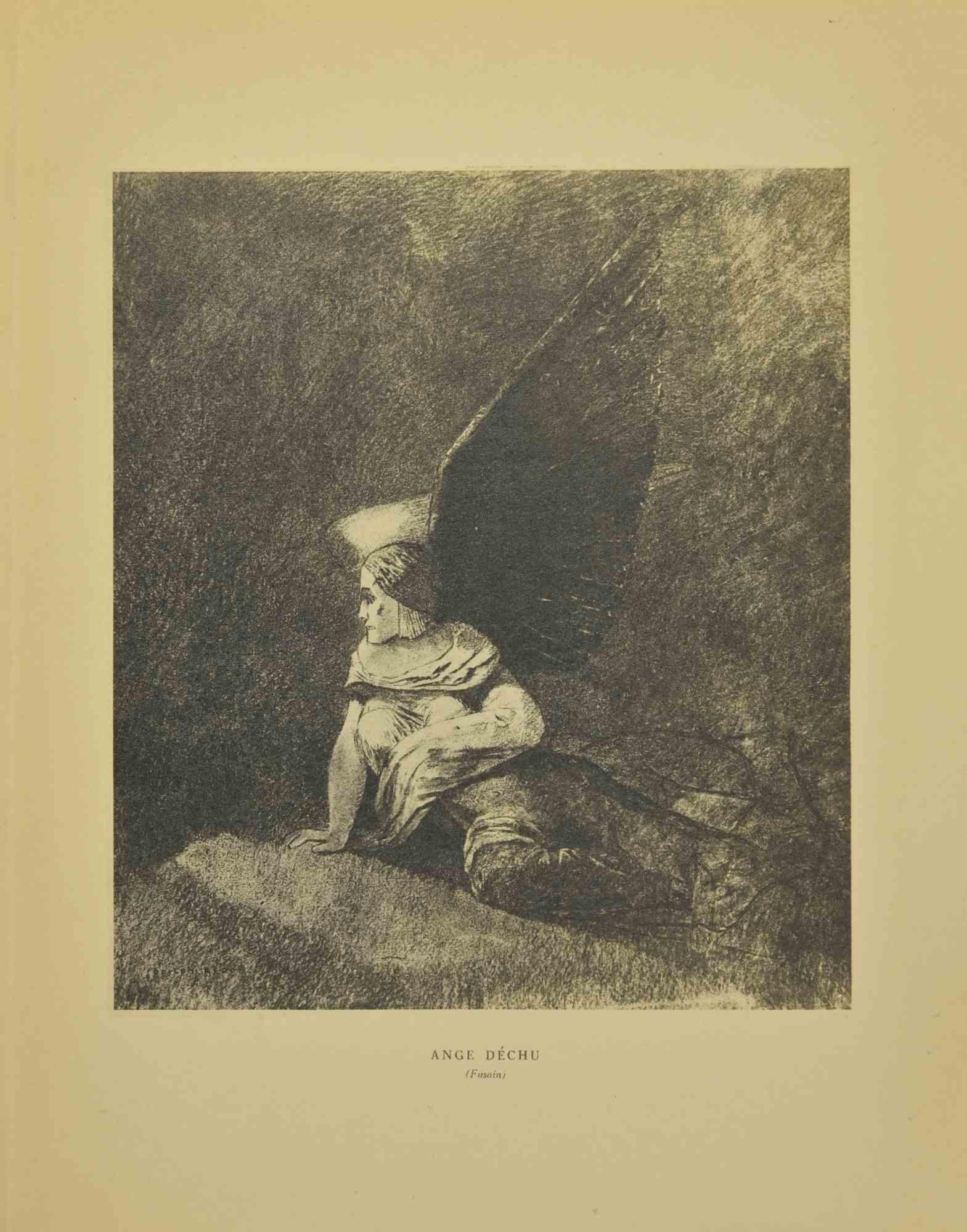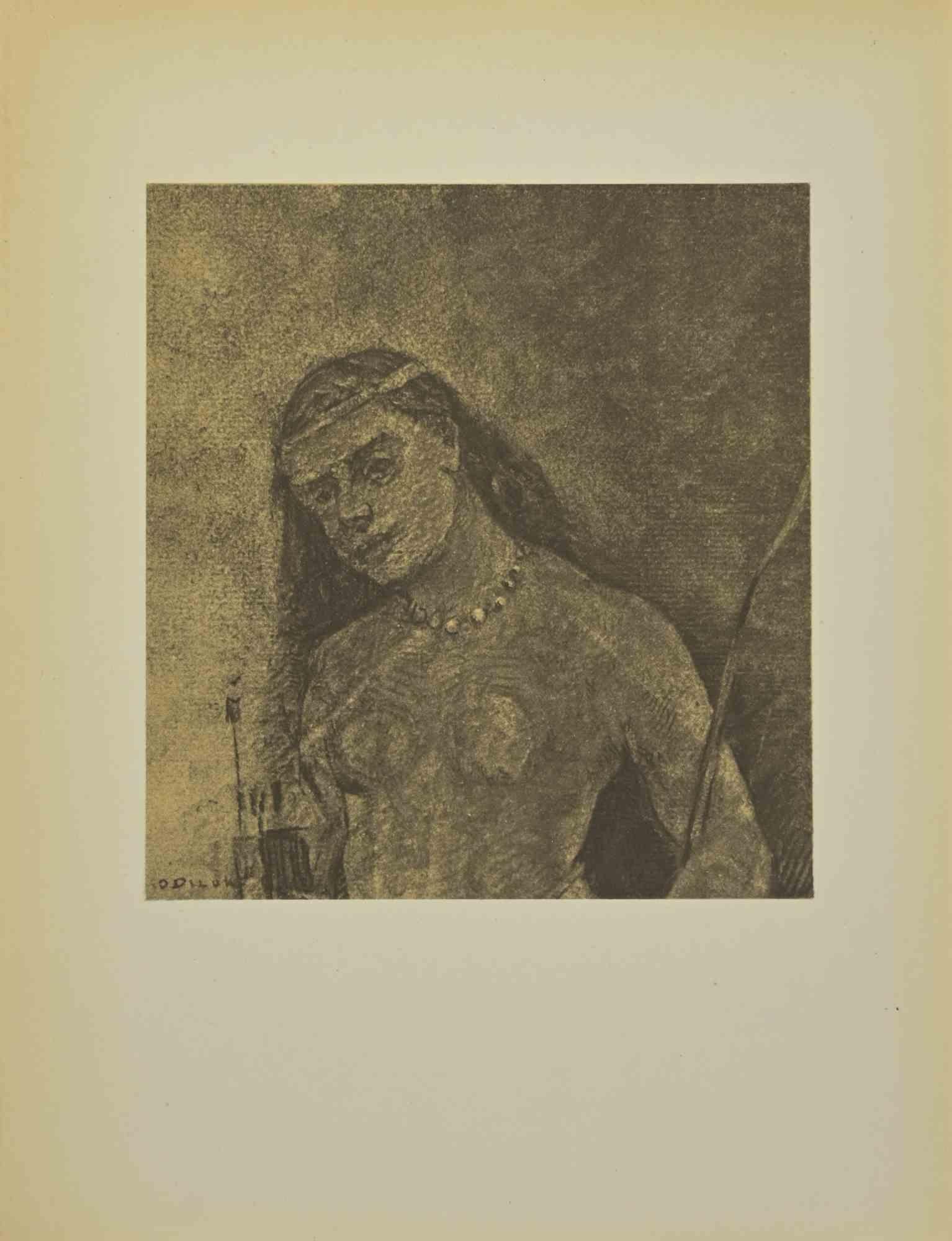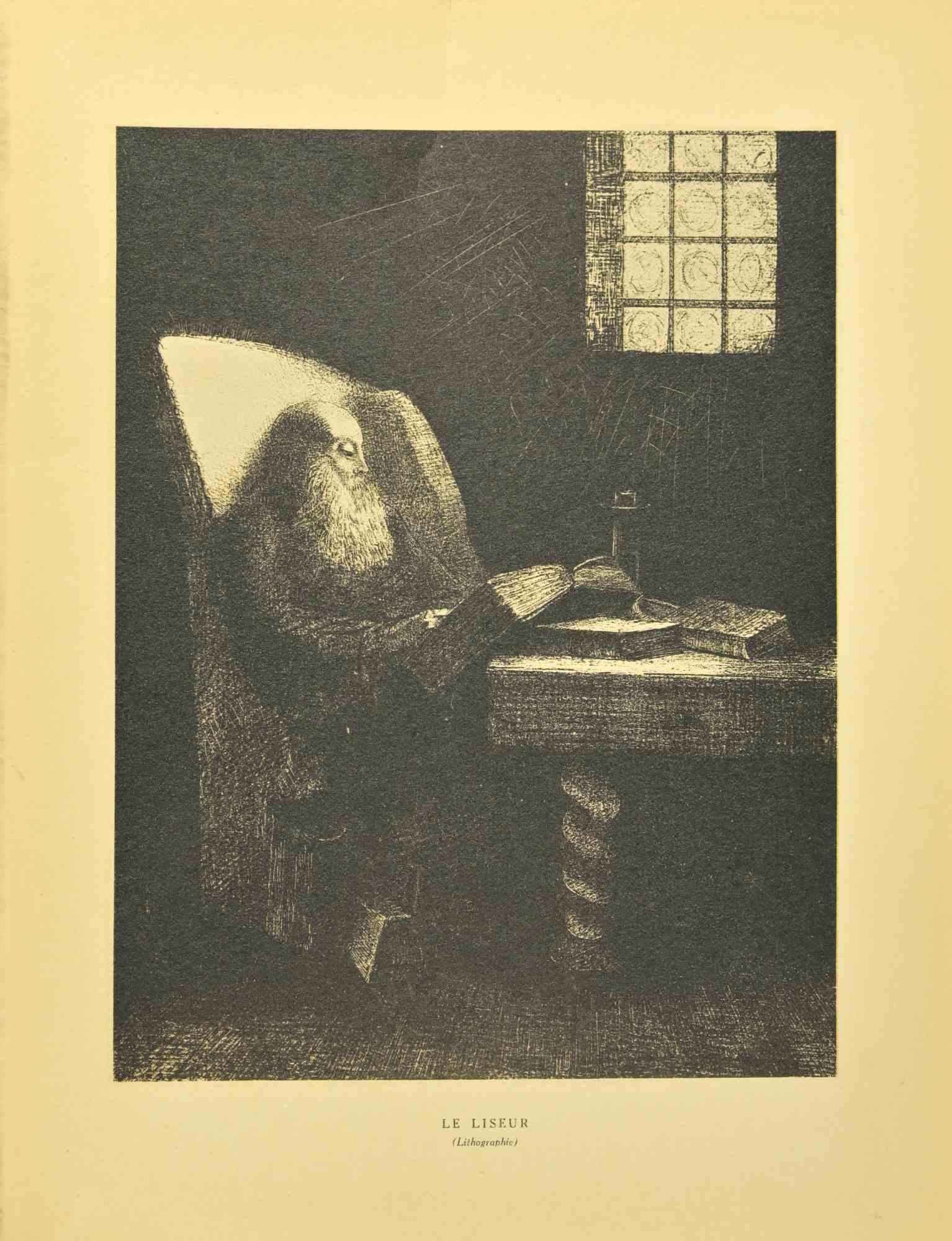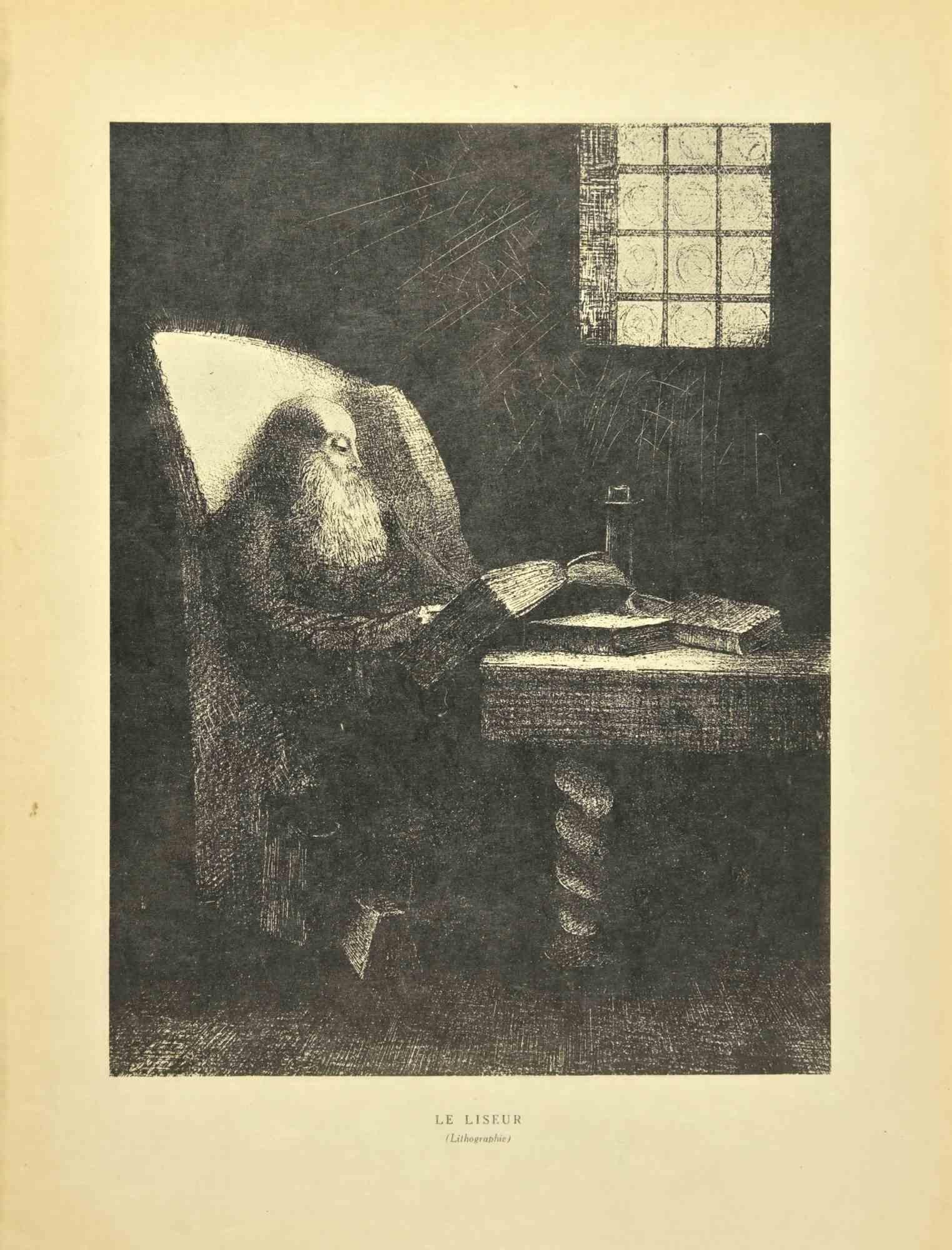Items Similar to Aman Jean, Sous les Fleurs (Lugt 2790), L'Estampe Moderne (after)
Want more images or videos?
Request additional images or videos from the seller
1 of 8
Aman Jean, Sous les Fleurs (Lugt 2790), L'Estampe Moderne (after)1897
1897
About the Item
Lithograph on wove paper. Inscription: Unsigned and unnumbered. Good Condition. Notes: From L'Estampe Moderne, published by F. Champenois, Paris, 1897.
EDMOND FRANÇOIS AMAN-JEAN (1858-1936) was a French symbolist painter, who co-founded the Salon des Tuileries in 1923. Aman-Jean established his reputation primarily for his portraits, especially of female subjects; he was also noted for his murals in public and official buildings, including the Sorbonne. Like many French artists of his generation, he was influenced by the new perspectives on Japanese art current in Paris in his day; more unusually, he was interested in the Pre-Raphaelite artists in England. He was a close friend of Georges Seurat; the two artists shared a Paris studio in 1879. Art historian Robert Herbert called Seurat's portrait of Aman-Jean, "one of the great portrait drawings of the nineteenth century." It was the first work Seurat showed, at the Paris Salon in 1883. Aman-Jean also worked in lithography and printmaking and designed posters. He was an influence to Picasso.
- Creation Year:1897
- Dimensions:Height: 16 in (40.64 cm)Width: 12 in (30.48 cm)
- Medium:
- Movement & Style:
- After:Edmond Aman Jean (1858 - 1936, French)
- Period:
- Condition:“Excellent Condition; never framed or matted”.
- Gallery Location:Auburn Hills, MI
- Reference Number:1stDibs: LU1465214131772
About the Seller
4.9
Gold Seller
These expertly vetted sellers are highly rated and consistently exceed customer expectations.
Established in 2002
1stDibs seller since 2021
868 sales on 1stDibs
Typical response time: 1 hour
- ShippingRetrieving quote...Ships From: Clinton Township, MI
- Return PolicyA return for this item may be initiated within 1 day of delivery.
Auctions on 1stDibs
Our timed auctions are an opportunity to bid on extraordinary design. We do not charge a Buyer's Premium and shipping is facilitated by 1stDibs and/or the seller. Plus, all auction purchases are covered by our comprehensive Buyer Protection. Learn More
More From This SellerView All
- Braque, Le Coq, Verve: Revue Artistique et Littéraire (after)By Georges BraqueLocated in Auburn Hills, MILithograph on vélin du Marais paper. Inscription: Unsigned and unnumbered. Good condition. Notes: From the volume, Verve: Revue Artistique et Littéraire, Vol. VII, N° 27-28, 1952. P...Category
1950s Modern Figurative Prints
MaterialsLithograph
- Rouault, Portrait, Divertissement (after)By Georges RouaultLocated in Auburn Hills, MILithograph on vélin d'Arches paper. Inscription: Unsigned and unnumbered, as issued. Good condition. Notes: From the folio, Divertissement, 1943. Published by Tériade, éditeur, Éditions de la Revue Verve, Paris; printed by Draeger Frères, Paris, February 1943. Excerpted from the folio (translated from French), This Manuscript entirely painted by Georges Rouault was engraved by the Master Printers, Draeger Frères and finished printing by them in February 1943 under the direction of Tériade for the Éditions de la Revue Verve. It was taken from this volume: XL examples on papier de Chine ancien with suite, numbered from I to XL, MCC examples on vélin d'Arches made especially for this volume numbered from XLI to MCCXL and XXX examples on Arches marked from I to XXX. GEORGES ROUAULT (1871-1958) French painter, printmaker, ceramicist, and maker of stained glass who, drawing inspiration from French medieval masters, united religious and secular traditions divorced since the Renaissance. Rouault was born in a cellar in Paris during a bombardment of the city by the forces opposed to the Commune. His father was a cabinetmaker. A grandfather took an interest in art and owned a collection of Honoré Daumier’s lithographs...Category
1940s Modern Figurative Prints
MaterialsLithograph
- Masson, Le Torrent, Verve: Revue Artistique et Littéraire (after)By André MassonLocated in Auburn Hills, MILithograph on vélin du Marais paper. Inscription: Unsigned and unnumbered. Good condition, with centerfold, as issued. Notes: From the volume, Verve: Revue Artistique et Littéraire, ...Category
1950s Modern Figurative Prints
MaterialsLithograph
- Marchand, Composition, pierre ã feu provence noire (after)By André MarchandLocated in Auburn Hills, MILithograph on vélin du Canson & Montgolfier Vidalon-Les-Annonay paper. Unsigned and unnumbered, as issued. Good Condition; never framed or matted. Notes: From the volume, pierre ã fe...Category
1940s Modern Figurative Prints
MaterialsLithograph
- Borés, La femme en bleu, Verve: Revue Artistique et Littéraire (after)By Francisco BoresLocated in Auburn Hills, MILithograph on vélin du Marais paper. Inscription: Unsigned and unnumbered. Good condition. Notes: From the volume, Verve: Revue Artistique et Littéraire, Vol. VII, N° 27-28, 1952. Printed by Mourlot Freres, Paris, 1952. FRANCISCO BORES (1898-1972) was an important figure of twentieth-century European art. His presence was important among the second wave of Spanish artists who arrived in Paris in the 1920s, which also included Pablo Picasso, Ginés Parra, Pedro Flores...Category
1950s Modern Figurative Prints
MaterialsLithograph
- Matisse, Figure Study, Derrière le miroir (after)By Henri MatisseLocated in Auburn Hills, MILithograph on wove paper. Inscription: Signed in plate and unnumbered; text on verso, as issued. Good Condition. Notes: From Derrière le miroir, N° 46-47, published by Derrière le mi...Category
1950s Modern Figurative Prints
MaterialsLithograph
You May Also Like
- Abel Pann Israeli Bezalel School Lithograph Judaica Biblical Print Jewish ArtBy Abel PannLocated in Surfside, FLAbel Pann (1883–1963) was a European Jewish painter who settled in the Talpiot neighborhood of Jerusalem in the early twentieth century and taught at the Bezalel Academy of Art under Boris Schatz. Abba Pfeffermann (later Abel Pann), born in Latvia or in Kreskowka, Vitebsk, Belarus, was a European Russian Jewish art...Category
Mid-20th Century Symbolist Figurative Prints
MaterialsLithograph
- Abel Pann Israeli Bezalel School Lithograph Judaica Biblical Print Jewish ArtBy Abel PannLocated in Surfside, FLAbel Pann (1883–1963) was a European Jewish painter who settled in the Talpiot neighborhood of Jerusalem in the early twentieth century and taught at the Bezalel Academy of Art under Boris Schatz. Abba Pfeffermann (later Abel Pann), born in Latvia or in Kreskowka, Vitebsk, Belarus, was a European Russian Jewish artist who immigrated to Ottoman Palestine and settled in Jerusalem. He was married to Esther Nussbaum. Pann's youngest son was killed in the 1947–1949 Palestine war. After that loss, he turned to painting scenes of the Holocaust. He died in Jerusalem in 1963. Pann studied the fundamentals of drawing for three months with the painter Yehuda Pen of Vitebsk, who also taught Marc Chagall. In his youth, he traveled in Russia and Poland, earning a living mainly as an apprentice in sign workshops. In 1898 he went south to Odessa, where he was accepted into the Academy of Fine Arts. In 1903, he was in Kishinev, where he documented the Kishinev pogrom with drawings; an effort that is thought to have contributed to his self-definition as an artist who chronicles Jewish history. Still in 1903, he moved to Paris, where he rented rooms in La Ruche, a Parisian building (which still exists) where Modigliani, Chagall, Chaim Soutine and other Jewish artists also lived. Pann studied at the French Academy under William-Adolphe Bouguereau. He earned his living primarily by drawing pictures for the popular illustrated newspapers of the era. In 1912, Boris Schatz, founder and director of the Bezalel Academy of Arts and Design visited Pann in Paris and invited him to come work in Jerusalem. In 1913, after traveling in Southern Europe and Egypt, Pann arrived in Jerusalem, where he had decided to settle for life. Pann went to see Schatz and it was decided that he would head the painting department at the Bezalel Academy for several months while Schatz embarked on an extensive overseas fund-raising trip. According to Haaretz art critic Smadar Sheffi, a work form this period with the simple title "Jerusalem" shows a cluster of buildings at sunset "with a sky in blazing orange." The painting is "more expressive and abstract that is typical of his work," and Sheffi speculates that "the encounter with the city" of Jerusalem was a "strong emotional experience" for the artist. Pann returned to Europe to arrange his affairs before moving permanently to the British Mandate of Palestine, but was caught on the continent by World War I. Pann's wartime paintings would prove to be among "the most important" of his career. He made many posters to support the French war effort. He also made a series of fifty drawings showing the extreme suffering of Jewish communities caught in the fighting between Germany, Poland and Russia. Art critic Smadar Sheffi regards them as "the most important part of his oeuvre." These "shocking" drawings put modern viewers in mind of depictions of the Holocaust. Pann's drawings were intended as journalistic documentation of the fighting and were successfully exhibited in the United States during the War. According to Pann's autobiography, the Russians, who were allied with the French, refused to allow a wartime exhibition of the drawings in France. According to The New York Times, the drawings were published in Paris during the war, but the government intervened to block their distribution on the grounds that they "reflected damagingly upon an ally" (Russia). Upon his return to Jerusalem in 1920, Pann took up a teaching position at the Bezalel Academy and wrote that he was about to embark on his life-work, the painting and drawing of scenes from the Hebrew Bible. He returned briefly to Vienna, where he met and married Esther Nussbaum and purchased a lithographic press, which the couple brought home to Jerusalem. Pann began work on a series of lithographs intended to be published in an enormous illustrated Bible, and although that series was never completed, he is widely admired for the series of pastels inspired by Bible stories that he began in the 1940s. The iconography of these works is linked to the 19th century orientalism. He was part of a movement of contemporary Jewish artists interested in Biblical scenes, including Ephraim Moses Lilien...Category
Mid-20th Century Symbolist Figurative Prints
MaterialsLithograph
- Abel Pann Israeli Bezalel School Lithograph Judaica Biblical Print Jewish ArtBy Abel PannLocated in Surfside, FLAbel Pann (1883–1963) was a European Jewish painter who settled in the Talpiot neighborhood of Jerusalem in the early twentieth century and taught at the Bezalel Academy of Art under...Category
Mid-20th Century Symbolist Figurative Prints
MaterialsLithograph
- Abel Pann Israeli Bezalel School Lithograph Judaica Biblical Print Jewish ArtBy Abel PannLocated in Surfside, FLAbel Pann (1883–1963) was a European Jewish painter who settled in the Talpiot neighborhood of Jerusalem in the early twentieth century and taught at the Bezalel Academy of Art under...Category
Mid-20th Century Symbolist Figurative Prints
MaterialsLithograph
- Abel Pann Israeli Bezalel School Lithograph Judaica Biblical Print Jewish ArtBy Abel PannLocated in Surfside, FLAbel Pann (1883–1963) was a European Jewish painter who settled in the Talpiot neighborhood of Jerusalem in the early twentieth century and taught at the Bezalel Academy of Art under Boris Schatz. Abba Pfeffermann (later Abel Pann), born in Latvia or in Kreskowka, Vitebsk, Belarus, was a European Russian Jewish artist who immigrated to Ottoman Palestine and settled in Jerusalem. He was married to Esther Nussbaum. Pann's youngest son was killed in the 1947–1949 Palestine war. After that loss, he turned to painting scenes of the Holocaust. He died in Jerusalem in 1963. Pann studied the fundamentals of drawing for three months with the painter Yehuda Pen of Vitebsk, who also taught Marc Chagall. In his youth, he traveled in Russia and Poland, earning a living mainly as an apprentice in sign workshops. In 1898 he went south to Odessa, where he was accepted into the Academy of Fine Arts. In 1903, he was in Kishinev, where he documented the Kishinev pogrom with drawings; an effort that is thought to have contributed to his self-definition as an artist who chronicles Jewish history. Still in 1903, he moved to Paris, where he rented rooms in La Ruche, a Parisian building (which still exists) where Modigliani, Chagall, Chaim Soutine and other Jewish artists also lived. Pann studied at the French Academy under William-Adolphe Bouguereau. He earned his living primarily by drawing pictures for the popular illustrated newspapers of the era. In 1912, Boris Schatz, founder and director of the Bezalel Academy of Arts and Design visited Pann in Paris and invited him to come work in Jerusalem. In 1913, after traveling in Southern Europe and Egypt, Pann arrived in Jerusalem, where he had decided to settle for life. Pann went to see Schatz and it was decided that he would head the painting department at the Bezalel Academy for several months while Schatz embarked on an extensive overseas fund-raising trip. According to Haaretz art critic Smadar Sheffi, a work form this period with the simple title "Jerusalem" shows a cluster of buildings at sunset "with a sky in blazing orange." The painting is "more expressive and abstract that is typical of his work," and Sheffi speculates that "the encounter with the city" of Jerusalem was a "strong emotional experience" for the artist. Pann returned to Europe to arrange his affairs before moving permanently to the British Mandate of Palestine, but was caught on the continent by World War I. Pann's wartime paintings would prove to be among "the most important" of his career. He made many posters to support the French war effort. He also made a series of fifty drawings showing the extreme suffering of Jewish communities caught in the fighting between Germany, Poland and Russia. Art critic Smadar Sheffi regards them as "the most important part of his oeuvre." These "shocking" drawings put modern viewers in mind of depictions of the Holocaust. Pann's drawings were intended as journalistic documentation of the fighting and were successfully exhibited in the United States during the War. According to Pann's autobiography, the Russians, who were allied with the French, refused to allow a wartime exhibition of the drawings in France. According to The New York Times, the drawings were published in Paris during the war, but the government intervened to block their distribution on the grounds that they "reflected damagingly upon an ally" (Russia). Upon his return to Jerusalem in 1920, Pann took up a teaching position at the Bezalel Academy and wrote that he was about to embark on his life-work, the painting and drawing of scenes from the Hebrew Bible. He returned briefly to Vienna, where he met and married Esther Nussbaum and purchased a lithographic press, which the couple brought home to Jerusalem. Pann began work on a series of lithographs intended to be published in an enormous illustrated Bible, and although that series was never completed, he is widely admired for the series of pastels inspired by Bible stories that he began in the 1940s. The iconography of these works is linked to the 19th century orientalism. He was part of a movement of contemporary Jewish artists interested in Biblical scenes, including Ephraim Moses Lilien...Category
Mid-20th Century Symbolist Figurative Prints
MaterialsLithograph
- Abel Pann Israeli Bezalel School Lithograph Judaica Biblical Print Jewish ArtBy Abel PannLocated in Surfside, FLAbel Pann (1883–1963) was a European Jewish painter who settled in the Talpiot neighborhood of Jerusalem in the early twentieth century and taught at the Bezalel Academy of Art under...Category
Mid-20th Century Symbolist Figurative Prints
MaterialsLithograph





